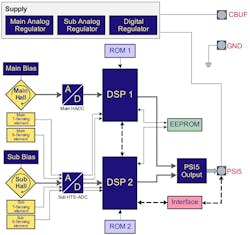Developed in full compliance with ISO 26262, which requires a system to keep functioning even if a single fault occurs, Infineon's XENSIV TLE4999I3 dual-channel Hall sensor enables development of fault-tolerant automotive systems. Such systems include electric steering (steering torque measurement), electric throttle control (throttle position), and pedal applications (pedal position).
With just one device, the TLE4999I3 provides high redundancy by means of two diverse Hall-sensor elements (referred to as the “main” Hall and “sub” Hall) with signal paths separate from each other within the chip (see figure). Internal control mechanisms carry out a plausibility check of the sensor data already within the chip. This secures the high diagnostic coverage required for premium functional-safety-compliant systems up to ASIL-D (ASIL stands for automotive safety integrity level; ASIL D classification represents the strictest level with the highest requirements).
As seen in this simplified block diagram, the TLE49913 features two digital-signal-processing units.
The TLE4999I3 supply architecture splits up into a digital-supply and two analog-supply circuits. This setup separates the fast-switching digital part from the noise-sensitive analog circuits. The two measurement channels have separate analog-supply domains controlled by the main and sub analog regulators. These regulators feed separate biasing units for the main and sub Hall-sensor elements.
The analog signal of the main Hall probe is fed into an analog-to-digital converter (main ADC) and then processed in a digital-signal-processing unit (DSP1). A multiplexed second ADC is used to convert analog signals from the main and sub temperature and stress sensing elements, and the sub Hall probe. The sub Hall, sub temperature, and sub stress signals are fed into the second digital-signal-processing unit (DSP2).
Each DSP uses its corresponding temperature, stress, and Hall signal, together with compensation parameters stored in EEPROM, to calculate a Hall measurement value that’s compensated for stress and temperature-drift effects. The two DSPs utilize their individual temperature, stress, and Hall signal information of the related sensor cell as well as the compensation parameters stored in the EEPROM to calculate two independent output values.
In addition to functional safety, the TLE4999I3 also offers high magnetic sensitivity with an error tolerance of less than 2%. The offset error drift, also an important parameter for magnetic sensors to determine the absolute position in a magnetic field, is a maximum 100 µT. This is just half that of comparable products, according to Infineon. The values of these parameters apply across the entire temperature range and lifetime of the product.
With the TLE4999I3, two magnetic ranges of ±12.5 mT and 25 mT can be adjusted. These low values allow for the use of relatively small and, consequently inexpensive, magnets.
The device features a PSI5 communication interface that supports a bit rate up to 189 kbaud. Physically, this is a current interface, the advantages of which are a low wiring effort and superior electromagnetic performance. The TLE4999I3 is suitable for those applications that are connected to the control unit over large distances—it supports cable lengths up to a distance of 12 m.
Configuration parameters can be programmed after assembly of the sensor in a module in an end-of-line calibration procedure that uses a two-wire SICI (serial inspection and configuration interface).
The TLE4999I3 sensor comes in a PG-SSO-3 package, which enables a high degree of flexibility due to its small space requirement and shape. The device is qualified according to AEC-Q100, Grade 0, and can thus be used in applications with ambient temperatures of 150°C during average operational conditions. The XENSIV TLE4999I3 is currently available for shipment.


